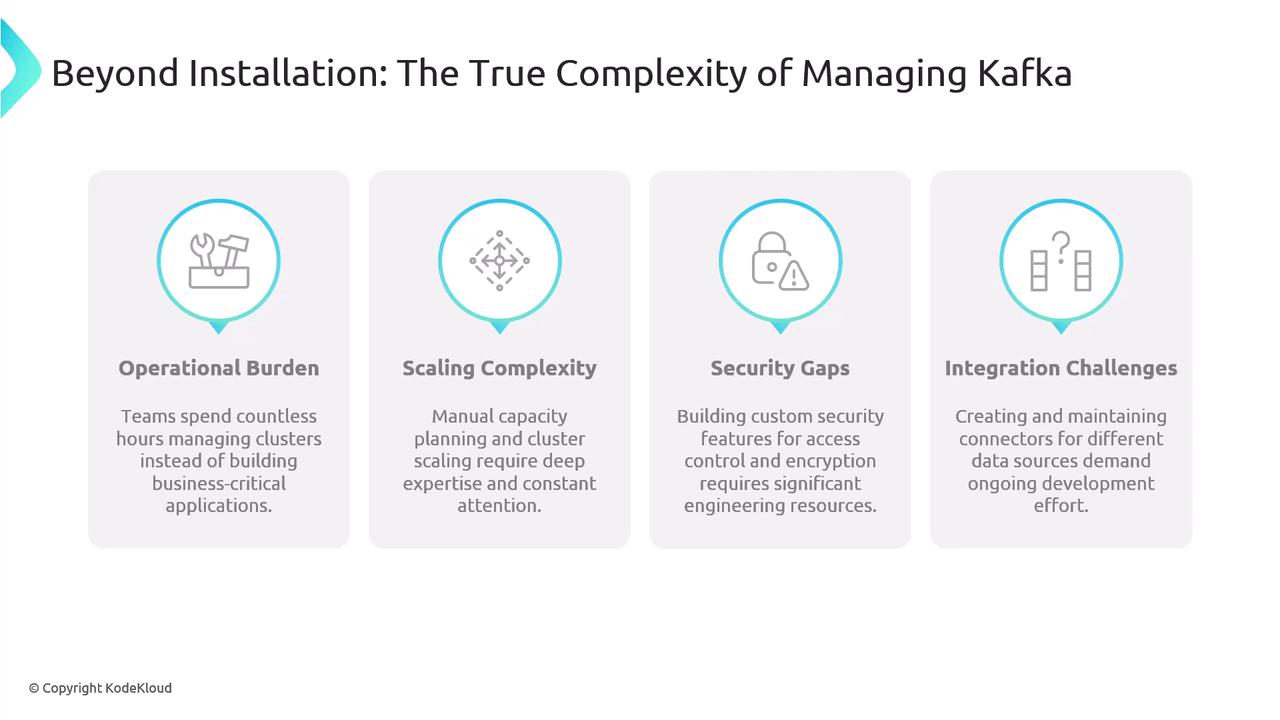Event Streaming with Kafka
Confluent Kafka and Its Offerings
Beyond Installation The True Complexity of Managing Kafka
Apache Kafka powers real-time data streams for countless enterprises, but running Kafka at scale goes far beyond a simple setup. This guide uncovers the hidden operational, scaling, security, and integration challenges you’ll face with a self-managed Kafka deployment—and why many teams turn to managed solutions.
The Appeal and Caveats of Open-Source Kafka
Apache Kafka’s open-source distribution offers unrivaled flexibility at no licensing cost. However, that freedom comes with significant responsibilities:
- No built-in monitoring dashboard or alerting
- Absence of out-of-the-box security and compliance controls
- High overhead for cluster maintenance, upgrades, and capacity planning
Note
Deploying open-source Kafka requires your team to build and maintain custom tools for health checks, metrics, and access control.
Without dedicated Kafka expertise, you’ll spend engineering cycles on operational plumbing instead of delivering business value.
Key Management Challenges
Managing your own Kafka cluster introduces four core areas of complexity:
| Challenge | Impact | Example Tasks |
|---|---|---|
| Operational Burden | Diverts resources from application dev | Broker health checks, log cleanup, version upgrades |
| Scaling Complexity | Risks downtime and imbalanced clusters | Partition rebalancing, replication tuning, rolling broker additions |
| Security Gaps | Exposes data to compliance and breach risk | SASL/SSL setup, ACL management, encryption, audit logs |
| Integration Hustles | Slows end-to-end data pipeline delivery | Connector builds, schema compatibility, multi-region DR |
1. Operational Burden
Keeping Kafka clusters healthy is a full-time job. Common chores include:
- Verifying broker liveness and performing log retention
- Creating, deleting, and reconfiguring topics
- Upgrading Zookeeper and Kafka versions with zero downtime
- Implementing backup, restore, and failure recovery plans
2. Scaling Complexity
Scaling Kafka manually demands deep know-how in cluster topology and capacity forecasting:
- Distributing partitions evenly across brokers
- Tuning replication factors to meet SLAs
- Monitoring disk, CPU, and network metrics
- Adding or removing brokers in rolling fashion to prevent service interruption

3. Security Gaps
Open-source Kafka ships with minimal security defaults. To achieve enterprise-grade protection, you must implement:
- Authentication (SASL/SSL, client certificates)
- Fine-grained authorization using ACL rules
- Encryption at rest and in transit
- Audit logging for compliance reporting
Warning
Skipping proper ACL configuration or encryption can expose sensitive business data and violate regulatory requirements.
4. Integration Challenges
Connecting Kafka to diverse systems often introduces friction:
- Building and maintaining custom connectors for databases, file systems, and cloud services
- Enforcing schema evolution and compatibility across producers/consumers
- Orchestrating multi-region replication and disaster recovery
- Monitoring end-to-end data flow and handling consumer backpressure

Conclusion
Operating an on-premises or self-managed Kafka cluster introduces substantial operational, security, scaling, and integration challenges. Many organizations simplify this by migrating to a managed event streaming platform like Confluent Cloud, which delivers secure, scalable Kafka as a service—so you can focus on building data-driven applications, not managing infrastructure.
Links and References
Watch Video
Watch video content